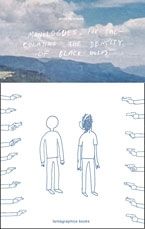Anders Nilsen makes improvisational storytelling entertaining, I'm happy to say. Nowhere is this more evident than his most recent Fantagraphics release (the second part in a trilogy and the follow up to Monologues for the Coming Plague), Monologues for Calculating the Density of Black Holes. I was fortunate enough to recently email interview Nilsen about his creative efforts.
Tim O'Shea: Monologues for Calculating the Density of Black Holes is the second in what will eventually be a trilogy, as you noted at your blog. Did you set out wanting to create a trilogy when you embarked on Monologues for the Coming Plague?
Anders Nilsen: When I started the first book I just thought I was doing some experiments in my sketchbook. Playing around. But once I had finished the material that comprises the first book I had started to see the potential for a more expanded form--the narrative had started to come together, characters develop, etc. I started thinking about it as a trilogy then.
O'Shea: In lettering the stories, you cross out text at certain points.What freedom do you enjoy by approaching these books as improvisational sketchbooks?
Nilsen: Just the ability to get the ideas and the progress of the narrative down quickly. It's a way to get ideas out before your internal critic can get ahold of them. Of course, sometimes they end up being stupid or go off in unproductive directions. So there is editing that happens. I want the end result to be readable and engaging. But preserving some of the untidiness of the process--the scribbled out bits--makes it clear (hopefully) that the process is in some way improvisational.
O'Shea: And why did you scratch out some text--while doing the freedom of information style black box on other excised text? One of the recurring characters has a scratched out face--did you ever consider giving the character a blacked out box for a face?
Nilsen: The difference is in where the decision happens...on the page or in photoshop after the page is scanned in. And I like the randomness and variety of the difference.
O'Shea: Throughout the book you utilize maps and large landscape photos as backgrounds for certain scenes. Where did you find these photos, and what motivated you to use them in such a manner? Were those pages some of the hardest to produce in the book?
Nilsen: Yeah, prepress-wise those pages are somewhat more complicated to make happen. To get the lines crisp on the color background. Many of the photographs are ones I took myself. Others I find. I collect old postcards or other imagery of landscapes. I'm drawn to the genre--the fine lines between a boring image and a majestic one, and how the way we interpret them changes over time. Also the arbitrary ways the character in the foreground may interact with what's going on behind him, the symbolism that's created and undermined at the same time.
O'Shea: Could you have done this book in black and white--and if not, given the minimalism of several pages, why do you opt to do those pages in color?
Nilsen: I'm interested in separating the sections visually, and also just making them a little more visually interesting. Again, by doing the changes in color between sections you are cuing the reader that there is some change in content. There may or may not actually be any, but it sets up an expectation. Which is fun to manipulate.
O'Shea: Given your affinity for stream-of-consciousness work, what creators that pursue work in a similar vein seem to inform your approach, if anyone?
Nilsen: The person I keep going back to is Chester Brown in Ed the Happy Clown. It's really great to see his mind working and his ambition expanding over the course of that story. Someone introduced me to David Shrigley's work after MFTCP came out and I really like the surprising, improvisational nature of his stuff.
O'Shea: At a weighty 400+ plus pages, was there anything you edited out for space? Granted there is intentionally limited editing on this book, but did you edit yourself or have someone edit it for you?
Nilsen: I edited it. I had a few people look at it and give me feedback. There was a lot of material that didn't make it in, there was also stuff added after a couple of re-readings. I did a significant re-write after the book was already solicited at 400 pages and ended up adding a bunch of stuff, and having to squeeze it in. This book has a lot more two, three and four panel pages than the first one, partly because of that. The flexibility of not having a panel structure is helpful.
O'Shea: Do you expect the average reader to get the gist of your message on a first read--or is Monologues for Calculating the Density of Black Holes a work that you think demands that the consumer read it multiple times to get the full impact of your work?
Nilsen: I don't know. I suppose I would hope with most of my work that people are compelled, because they are interested enough, to reread it, and that they find something they didn't see before that makes it worth the effort. But if someone finds it to be confusing nonesense and decides to throw it into the swimming pool that's okay, too. Probably some of it won't make sense until the story is wrapped up in the third book.
O'Shea: With two books in the trilogy under your belt, have you developed an affinity for certain characters more than others?
Nilsen: I like them all. I think I've gotten slightly less interested in the guy with the face, the guy looking for a job. Which is a problem because I think he's sort of important.
O'Shea: Creatively what else is on the horizon for you in 2009?
Nilsen: I'm doing my damnedest to get Big Questions done. I still have about a hundred pages to draw. We'll see.


